0-30 Vdc Stabilized Power Supply with Current Control 0.002-3 A
- 1.023.721 Views
- medium
- Tested
Copyright of this circuit belongs to smart kit electronics. In this page we will use this circuit to discuss for improvements and we will introduce some changes based on original schematic.
General Description
This is a high quality power supply with a continuously variable stabilised output adjustable at any value between 0 and 30VDC. The circuit also incorporates an electronic output current limiter that effectively controls the output current from a few milliamperes (2 mA) to the maximum output of three amperes that the circuit can deliver. This feature makes this power supply indispensable in the experimenters laboratory as it is possible to limit the current to the typical maximum that a circuit under test may require, and power it up then, without any fear that it may be damaged if something goes wrong. There is also a visual indication that the current limiter is in operation so that you can see at a glance that your circuit is exceeding or not its preset limits.
Technical Specifications
- Input Voltage: ……………. 24 VAC
- Input Current: ……………. 3 A (max)
- Output Voltage: …………. 0-30 V adjustable
- Output Current: …………. 2 mA-3 A adjustable
- Output Voltage Ripple: …. 0.01 % maximum
- PCB dimensions: 123 x 85 mm
Features
- Reduced dimensions, easy construction, simple operation.
- Output voltage easily adjustable.
- Output current limiting with visual indication.
- Complete protection of the supplied device against over loads and malfunction.
How it Works
To start with, there is a step-down mains transformer with a secondary winding rated at 24 V/3 A, which is connected across the input points of the circuit at pins 1 & 2. (the quality of the supplies output will be directly proportional to the quality of the transformer). The AC voltage of the transformers secondary winding is rectified by the bridge formed by the four diodes D1-D4. The DC voltage taken across the output of the bridge is smoothed by the filter formed by the reservoir capacitor C1 and the resistor R1. The circuit incorporates some unique features which make it quite different from other power supplies of its class. Instead of using a variable feedback arrangement to control the output voltage, our circuit uses a constant gain amplifier to provide the reference voltage necessary for its stable operation. The reference voltage is generated at the output of U1.
The circuit operates as follows: The diode D8 is a 5.6 V zener, which here operates at its zero temperature coefficient current. The voltage in the output of U1 gradually increases till the diode D8 is turned on. When this happens the circuit stabilises and the Zener reference voltage (5.6 V) appears across the resistor R5. The current which flows through the non inverting input of the op-amp is negligible, therefore the same current flows through R5 and R6, and as the two resistors have the same value the voltage across the two of them in series will be exactly twice the voltage across each one. Thus the voltage present at the output of the op-amp (pin 6 of U1) is 11.2 V, twice the zeners reference voltage. The integrated circuit U2 has a constant amplification factor of approximately 3 X, according to the formula A=(R11+R12)/R11, and raises the 11.2 V reference voltage to approximately 33 V. The trimmer RV1 and the resistor R10 are used for the adjustment of the output voltages limits so that it can be reduced to 0 V, despite any value tolerances of the other components in the circuit.
Another very important feature of the circuit, is the possibility to preset the maximum output current which can be drawn from the p.s.u., effectively converting it from a constant voltage source to a constant current one. To make this possible the circuit detects the voltage drop across a resistor (R7) which is connected in series with the load. The IC responsible for this function of the circuit is U3. The inverting input of U3 is biased at 0 V via R21. At the same time the non inverting input of the same IC can be adjusted to any voltage by means of P2.
Let us assume that for a given output of several volts, P2 is set so that the input of the IC is kept at 1 V. If the load is increased the output voltage will be kept constant by the voltage amplifier section of the circuit and the presence of R7 in series with the output will have a negligible effect because of its low value and because of its location outside the feedback loop of the voltage control circuit. While the load is kept constant and the output voltage is not changed the circuit is stable. If the load is increased so that the voltage drop across R7 is greater than 1 V, IC3 is forced into action and the circuit is shifted into the constant current mode. The output of U3 is coupled to the non inverting input of U2 by D9. U2 is responsible for the voltage control and as U3 is coupled to its input the latter can effectively override its function. What happens is that the voltage across R7 is monitored and is not allowed to increase above the preset value (1 V in our example) by reducing the output voltage of the circuit.
This is in effect a means of maintaining the output current constant and is so accurate that it is possible to preset the current limit to as low as 2 mA. The capacitor C8 is there to increase the stability of the circuit. Q3 is used to drive the LED whenever the current limiter is activated in order to provide a visual indication of the limiters operation. In order to make it possible for U2 to control the output voltage down to 0 V, it is necessary to provide a negative supply rail and this is done by means of the circuit around C2 & C3. The same negative supply is also used for U3. As U1 is working under fixed conditions it can be run from the unregulated positive supply rail and the earth.
The negative supply rail is produced by a simple voltage pump circuit which is stabilised by means of R3 and D7. In order to avoid uncontrolled situations at shut-down there is a protection circuit built around Q1. As soon as the negative supply rail collapses Q1 removes all drive to the output stage. This in effect brings the output voltage to zero as soon as the AC is removed protecting the circuit and the appliances connected to its output. During normal operation Q1 is kept off by means of R14 but when the negative supply rail collapses the transistor is turned on and brings the output of U2 low. The IC has internal protection and can not be damaged because of this effective short circuiting of its output. It is a great advantage in experimental work to be able to kill the output of a power supply without having to wait for the capacitors to discharge and there is also an added protection because the output of many stabilised power supplies tends to rise instantaneously at switch off with disastrous results.
Construction
First of all let us consider a few basics in building electronic circuits on a printed circuit board. The board is made of a thin insulating material clad with a thin layer of conductive copper that is shaped in such a way as to form the necessary conductors between the various components of the circuit. The use of a properly designed printed circuit board is very desirable as it speeds construction up considerably and reduces the possibility of making errors. To protect the board during storage from oxidation and assure it gets to you in perfect condition the copper is tinned during manufacturing and covered with a special varnish that protects it from getting oxidised and also makes soldering easier.
Soldering the components to the board is the only way to build your circuit and from the way you do it depends greatly your success or failure. This work is not very difficult and if you stick to a few rules you should have no problems. The soldering iron that you use must be light and its power should not exceed the 25 Watts. The tip should be fine and must be kept clean at all times. For this purpose come very handy specially made sponges that are kept wet and from time to time you can wipe the hot tip on them to remove all the residues that tend to accumulate on it.
DO NOT file or sandpaper a dirty or worn out tip. If the tip cannot be cleaned, replace it. There are many different types of solder in the market and you should choose a good quality one that contains the necessary flux in its core, to assure a perfect joint every time.
DO NOT use soldering flux apart from that which is already included in your solder. Too much flux can cause many problems and is one of the main causes of circuit malfunction. If nevertheless you have to use extra flux, as it is the case when you have to tin copper wires, clean it very thoroughly after you finish your work.
In order to solder a component correctly you should do the following:
- Clean the component leads with a small piece of emery paper.
- Bend them at the correct distance from the components body and insert he component in its place on the board.
- You may find sometimes a component with heavier gauge leads than usual, that are too thick to enter in the holes of the p.c. board. In this case use a mini drill to enlarge the holes slightly. Do not make the holes too large as this is going to make soldering difficult afterwards.
- Take the hot iron and place its tip on the component lead while holding the end of the solder wire at the point where the lead emerges from the board. The iron tip must touch the lead slightly above the p.c. board.
- When the solder starts to melt and flow wait till it covers evenly the area around the hole and the flux boils and gets out from underneath the solder.
- The whole operation should not take more than 5 seconds. Remove the iron and allow the solder to cool naturally without blowing on it or moving the component. If everything was done properly the surface of the joint must have a bright metallic finish and its edges should be smoothly ended on the component lead and the board track. If the solder looks dull, cracked, or has the shape of a blob then you have made a dry joint and you should remove the solder (with a pump, or a solder wick) and redo it. Take care not to overheat the tracks as it is very easy to lift them from the board and break them.
- When you are soldering a sensitive component it is good practice to hold the lead from the component side of the board with a pair of long-nose pliers to divert any heat that could possibly damage the component.
- Make sure that you do not use more solder than it is necessary as you are running the risk of short-circuiting adjacent tracks on the board, especially if they are very close together.
- When you finish your work, cut off the excess of the component leads and clean the board thoroughly with a suitable solvent to remove all flux residues that may still remain on it.
Construction (… continued)
As it is recommended start working by identifying the components and separating them in groups. Place first of all the sockets for the ICs and the pins for the external connections and solder them in their places. Continue with the resistors. Remember to mound R7 at a certain distance from the printed circuit board as it tends to become quite hot, especially when the circuit is supplying heavy currents, and this could possibly damage the board. It is also advisable to mount R1 at a certain distance from the surface of the PCB as well. Continue with the capacitors observing the polarity of the electrolytic and finally solder in place the diodes and the transistors taking care not to overheat them and being at the same time very careful to align them correctly.
Mount the power transistor on the heatsink. To do this follow the diagram and remember to use the mica insulator between the transistor body and the heatsink and the special fibber washers to insulate the screws from the heatsink. Remember to place the soldering tag on one of the screws from the side of the transistor body, this is going to be used as the collector lead of the transistor. Use a little amount of Heat Transfer Compound between the transistor and the heatsink to ensure the maximum transfer of heat between them, and tighten the screws as far as they will go.
Attach a piece of insulated wire to each lead taking care to make very good joints as the current that flows in this part of the circuit is quite heavy, especially between the emitter and the collector of the transistor.
It is convenient to know where you are going to place every thing inside the case that is going to accommodate your power supply, in order to calculate the length of the wires to use between the PCB and the potentiometers, the power transistor and for the input and output connections to the circuit. (It does not really matter if the wires are longer but it makes a much neater project if the wires are trimmed at exactly the length necessary).
Connect the potentiometers, the LED and the power transistor and attach two pairs of leads for the input and output connections. Make sure that you follow the circuit diagram very care fully for these connections as there are 15 external connections to the circuit in total and if you make a mistake it may be very difficult to find it afterwards. It is a good idea to use cables of different colours in order to make trouble shooting easier.
The external connections are:
- 1 & 2 AC input, the secondary of the transformer.
- 3 (+) & 4 (-) DC output.
- 5, 10 & 12 to P1.
- 6, 11 & 13 to P2.
- 7 (E), 8 (B), 9 (E) to the power transistor Q4.
- The LED should also be placed on the front panel of the case where it is always visible but the pins where it is connected at are not numbered.
When all the external connections have been finished make a very careful inspection of the board and clean it to remove soldering flux residues. Make sure that there are no bridges that may short circuit adjacent tracks and if everything seems to be all right connect the input of the circuit with the secondary of a suitable mains transformer. Connect a voltmeter across the output of the circuit and the primary of the transformer to the mains.
The voltmeter should measure a voltage between 0 and 30 VDC depending on the setting of P1, and should follow any changes of this setting to indicate that the variable voltage control is working properly. Turning P2 counter-clockwise should turn the LED on, indicating that the current limiter is in operation.
Data
Adjustments
If you want the output of your supply to be adjustable between 0 and 30 V you should adjust RV1 to make sure that when P1 is at its minimum setting the output of the supply is exactly 0 V. As it is not possible to measure very small values with a conventional panel meter it is better to use a digital meter for this adjustment, and to set it at a very low scale to increase its sensitivity.
Warning
While using electrical parts, handle power supply and equipment with great care, following safety standards as described by international specs and regulations.
CAUTION
This circuit works off the mains and there are 220 VAC present in some of its parts.
Voltages above 50 V are DANGEROUS and could even be LETHAL.
In order to avoid accidents that could be fatal to you or members of your family please observe the following rules:
- DO NOT work if you are tired or in a hurry, double check every thing before connecting your circuit to the mains and be ready
- to disconnect it if something looks wrong.
- DO NOT touch any part of the circuit when it is under power.
- DO NOT leave mains leads exposed. All mains leads should be well insulated.
- DO NOT change the fuses with others of higher rating or replace them with wire or aluminium foil.
- DO NOT work with wet hands.
- If you are wearing a chain, necklace or anything that may be hanging and touch an exposed part of the circuit BE CAREFUL.
- ALWAYS use a proper mains lead with the correct plug and earth your circuit properly.
- If the case of your project is made of metal make sure that it is properly earthen.
- If it is possible use a mains transformer with a 1:1 ratio to isolate your circuit from the mains.
- When you are testing a circuit that works off the mains wear shoes with rubber soles, stand on dry non conductive floor and keep one hand in your pocket or behind your back.
- If you take all the above precautions you are reducing the risks you are taking to a minimum and this way you are protecting yourself and those around you.
- A carefully built and well insulated device does not constitute any danger for its user.
If it does not work
Check your work for possible dry joints, bridges across adjacent tracks or soldering flux residues that usually cause problems.
Check again all the external connections to and from the circuit to see if there is a mistake there.
- See that there are no components missing or inserted in the wrong places.
- Make sure that all the polarised components have been soldered the right way round. – Make sure the supply has the correct voltage and is connected the right way round to your circuit.
- Check your project for faulty or damaged components.
Parts List
| Part | Value | Note |
|---|---|---|
| R1 | 2.2 kΩ | 1W |
| R2 | 82 Ω | 1/4W |
| R3 | 220 Ω | 1/4W |
| R4 | 4.7 kΩ | 1/4W |
| R5-R6-R13-R20-R21 | 10 kΩ | 1/4W |
| R7 | 0.47 Ω | 5W |
| R8-R11 | 27 kΩ | 1/4W |
| R9-R19 | 2.2 kΩ | 1/4W |
| R10 | 270 kΩ | 1/4W |
| R12-R18 | 56kΩ | 1/4W |
| R14 | 1.5 kΩ | 1/4W |
| R15-R16 | 1 kΩ | 1/4W |
| R17 | 33 Ω | 1/4W |
| R22 | 3.9 kΩ | 1/4W |
| RV1 | 100 kΩ | trimmer |
| P1-P2 | 10 kΩ | linear pontesiometer |
| C1 | 3300 uF/50V | electrolytic |
| C2-C3 | 47uF/50V | electrolytic |
| C4 | 100nF | polyester |
| C5 | 200nF | polyester |
| C6 | 100pF | ceramic |
| C7 | 10uF/50V | electrolytic |
| C8 | 330pF | ceramic |
| C9 | 100pF | ceramic |
| D1-D2-D3-D4 | 1N5402-3-4 | 2A diode - RAX GI837U |
| D5-D6 | 1N4148 | - |
| D7-D8 | 5.6V | Zener |
| D9-D10 | 1N4148 | - |
| D11 | 1N4001 | diode 1A |
| Q1 | BC548 | NPN transistor or BC547 |
| Q2 | 2N2219 | NPN transistor |
| Q3 | BC557 | PNP transistor or BC327 |
| Q4 | 2N3055 | NPN power transistor |
| U1-U2-U3 | TL081 | operational amplifier |
| D12 | LED diode | - |
Feedback
Another implementation of this power supply is located here – in Czech language
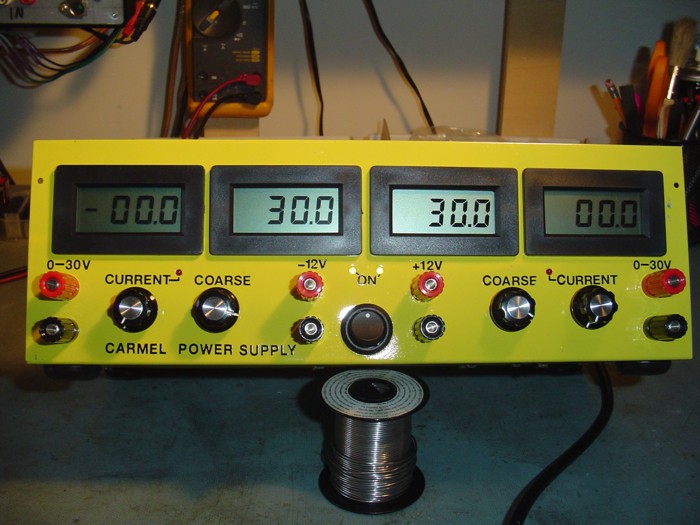
here is a board made by Sam Carmel and worked nice
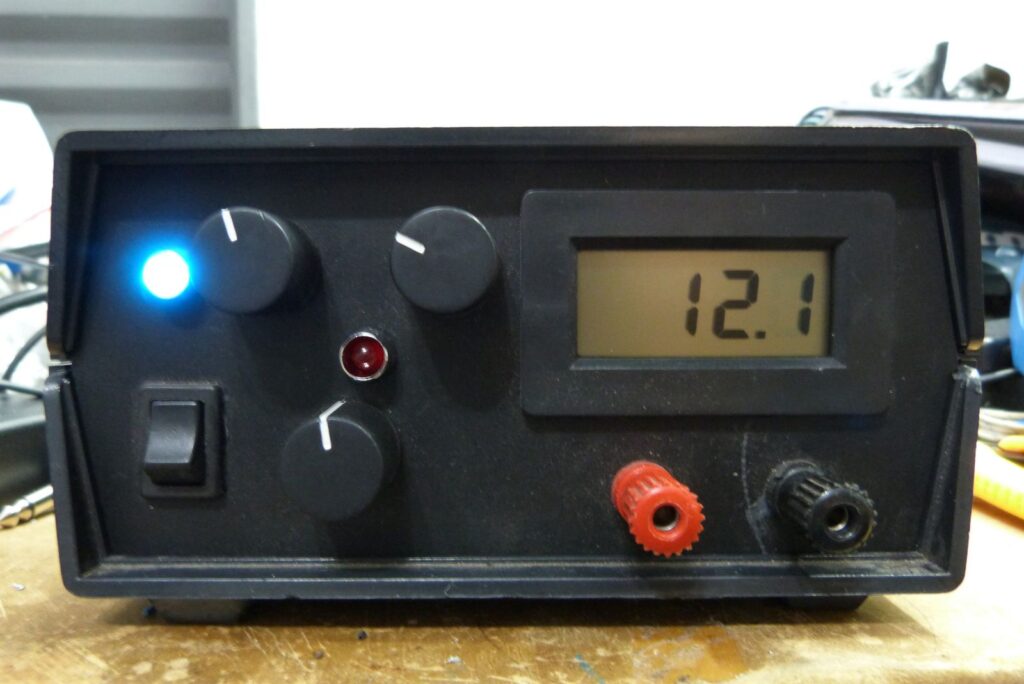
Daniel’s build of PSU – front view with LCD voltmeter
Potensiometers for coarse and fine voltage adjustment and current regulator
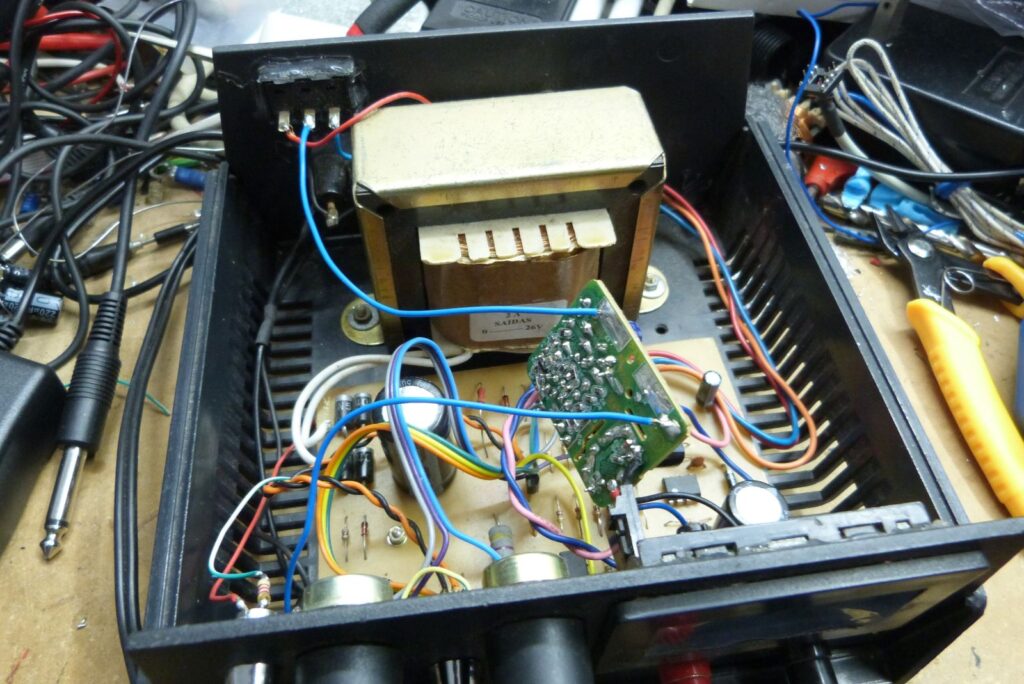
Daniel’s build of PSU – internal view. A mobile phone charger is used as power supply for voltmeter
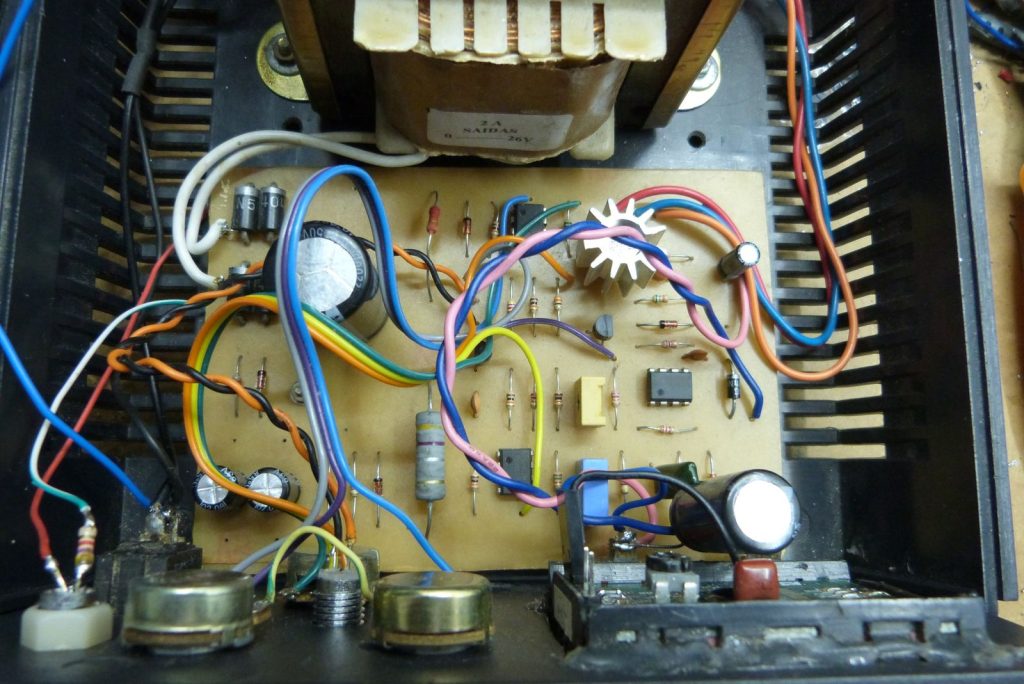
Daniel’s build of PSU – internal view. He is going to change 2200uF a 6800uF capacitor to reduce ripple in high load.
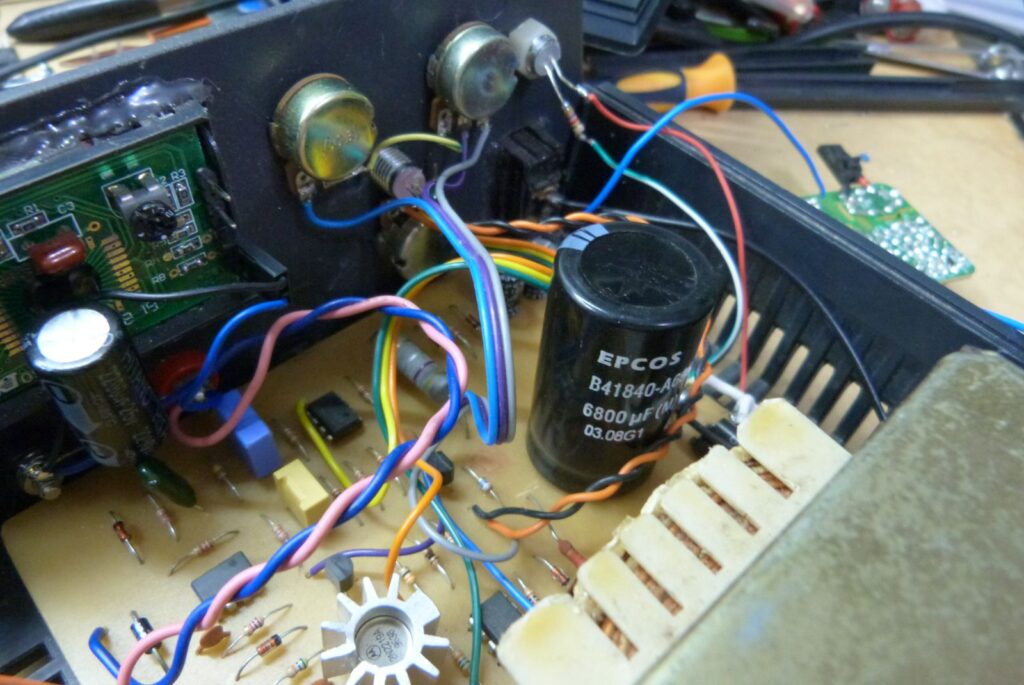
Daniel’s build of PSU – internal view. new capacitor (6800uF x 40V) to improve ripple filtering
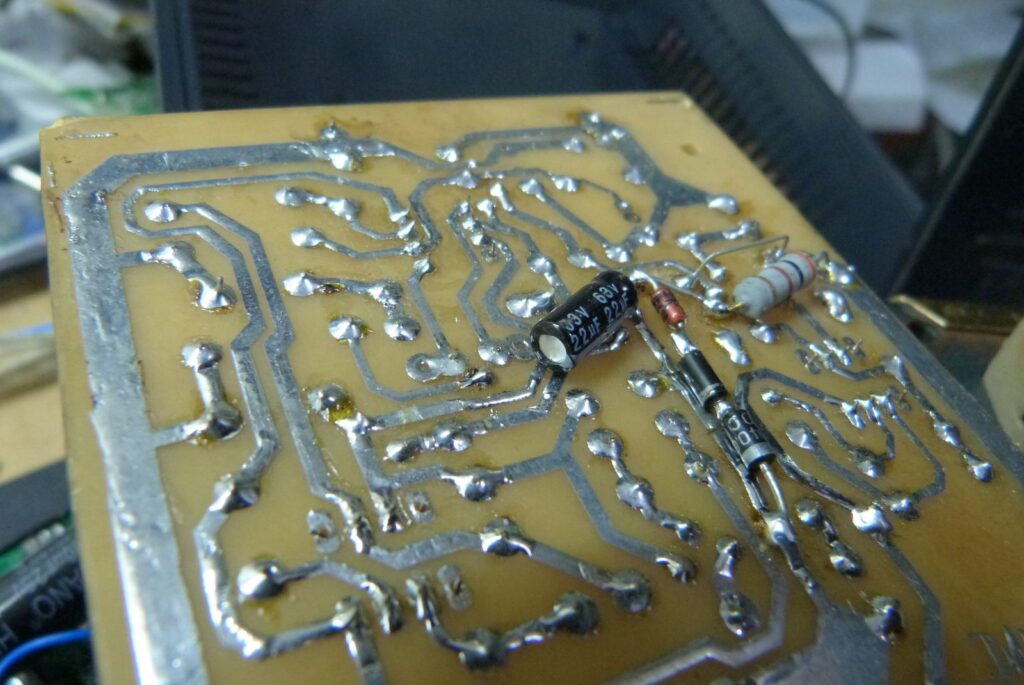
Daniel’s build of PSU – internal view. Modification to protect the LM311
Received the following email from Daniel on 06/2012:
I only face a problem with one of the biggest plagues in electronics now… Fake components. I bougth a fake 2N2219 and it last 100ms (or less) in my first try. As the piece was new I never suspected on it. I spent 2 hours looking for the problem and I could not believe when I test it… I had more two I bougth togeter, they had the same destiny… For my lucky I had a box with old components (some dates from the 70´s) and there I found a genuine Motorola 2N2219… This is running perfect. This was the only difficulty I found…
Received the following email from Ivan on 02/2010:
Ok. I bulid your project about a day ago. Mounted all the parts on the pcb and then concluded that there is some serious problems in this schematics. First, 2N3055 will overheat, so you have to connect two of them in parallel with emitter resistors 0.1ohm/5w. Second, maximal voltage between ‘+’ and ‘-‘ of TL081 is 36VDC.If you connect them as it is shown in this circuit diagram that voltage will be about 45VDC, so they will burn down immediately. To fix this problem you have to reconnect all pins number 7 of U1, U2 and U3, emitter of Q3 and ‘upper’ end of R19 to out of an 7809 with 18V zener diode between ‘common’ pin and ‘-‘ of 3300uF cap, and input of 7809 connect to ‘+’ of the same cap. Now, on pin number 7 and mentioned parts you’ll have 27VDC, and total voltage will be 32.6VDC. Third, instead of using 3300uF, use 4700 or 6800uF/63VDC to reduce the ripple on higher currents (2-3A). The rest of the circuit is perfect. I like it cause it is so inexpensive and easy to make with those simple reconstructions i mentioned.



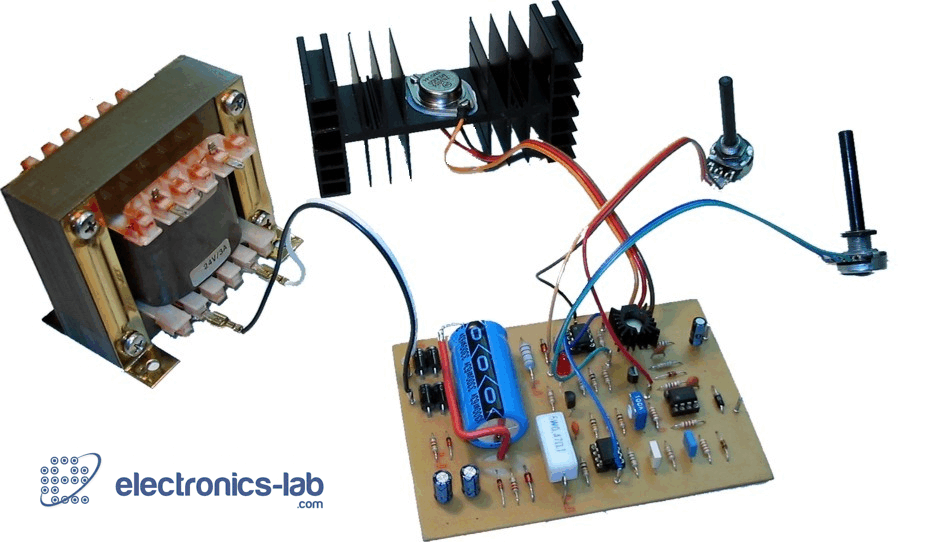
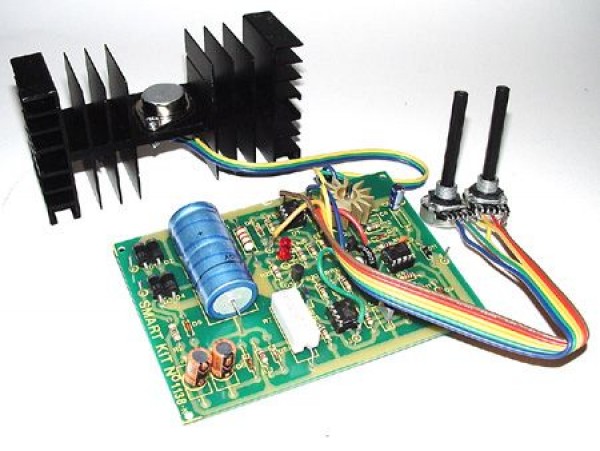
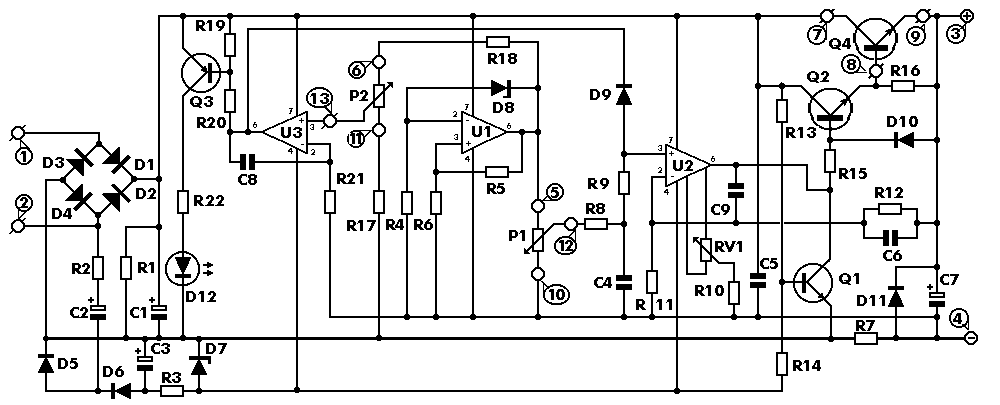


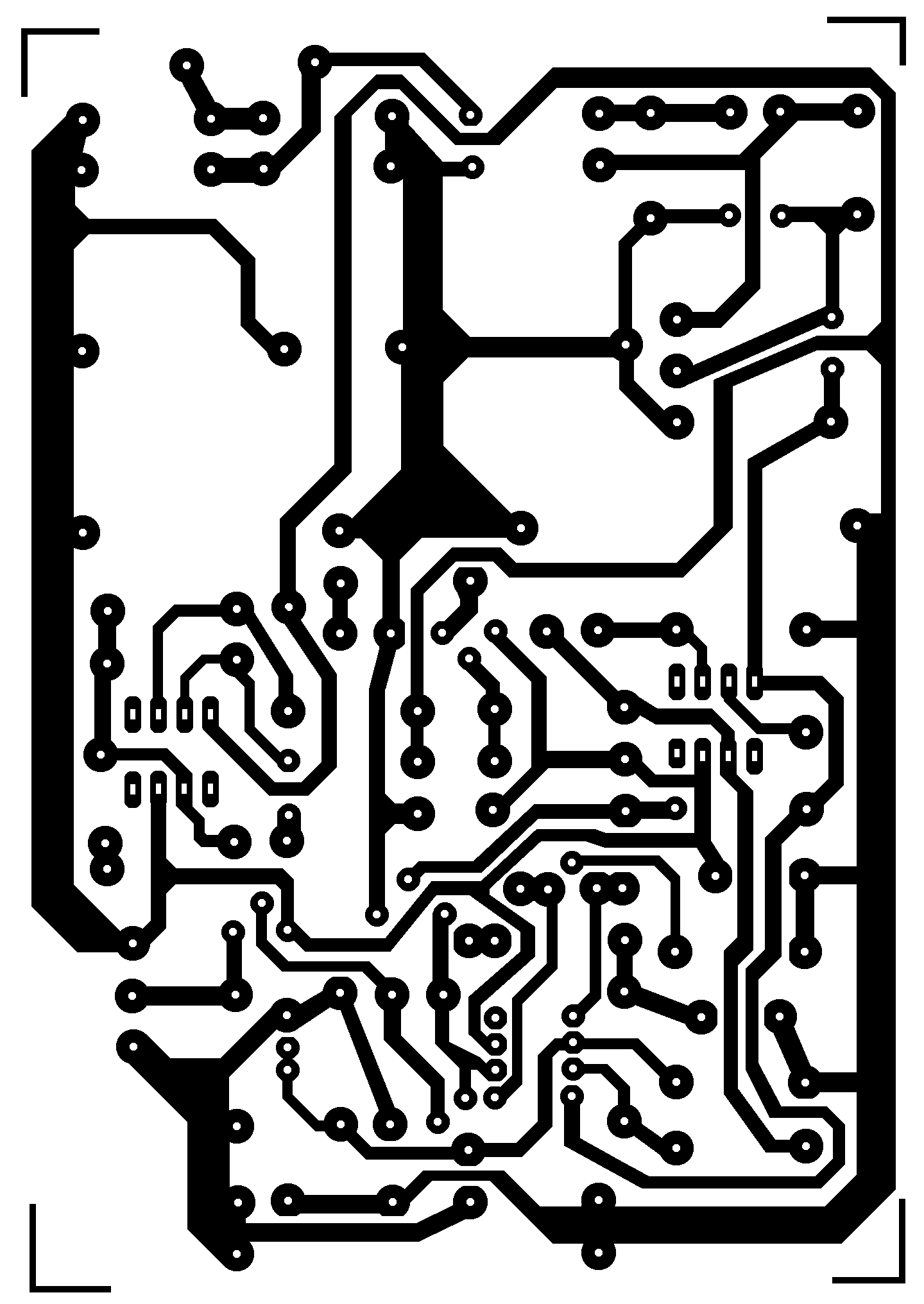
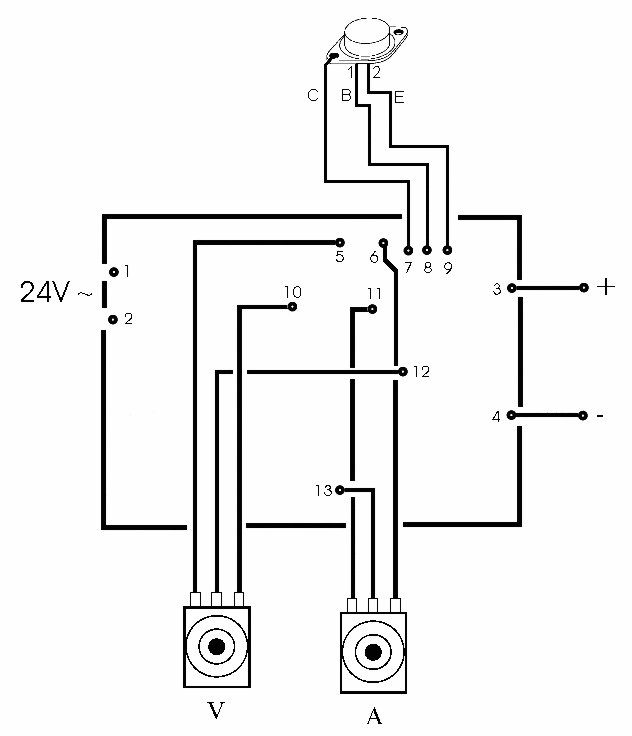
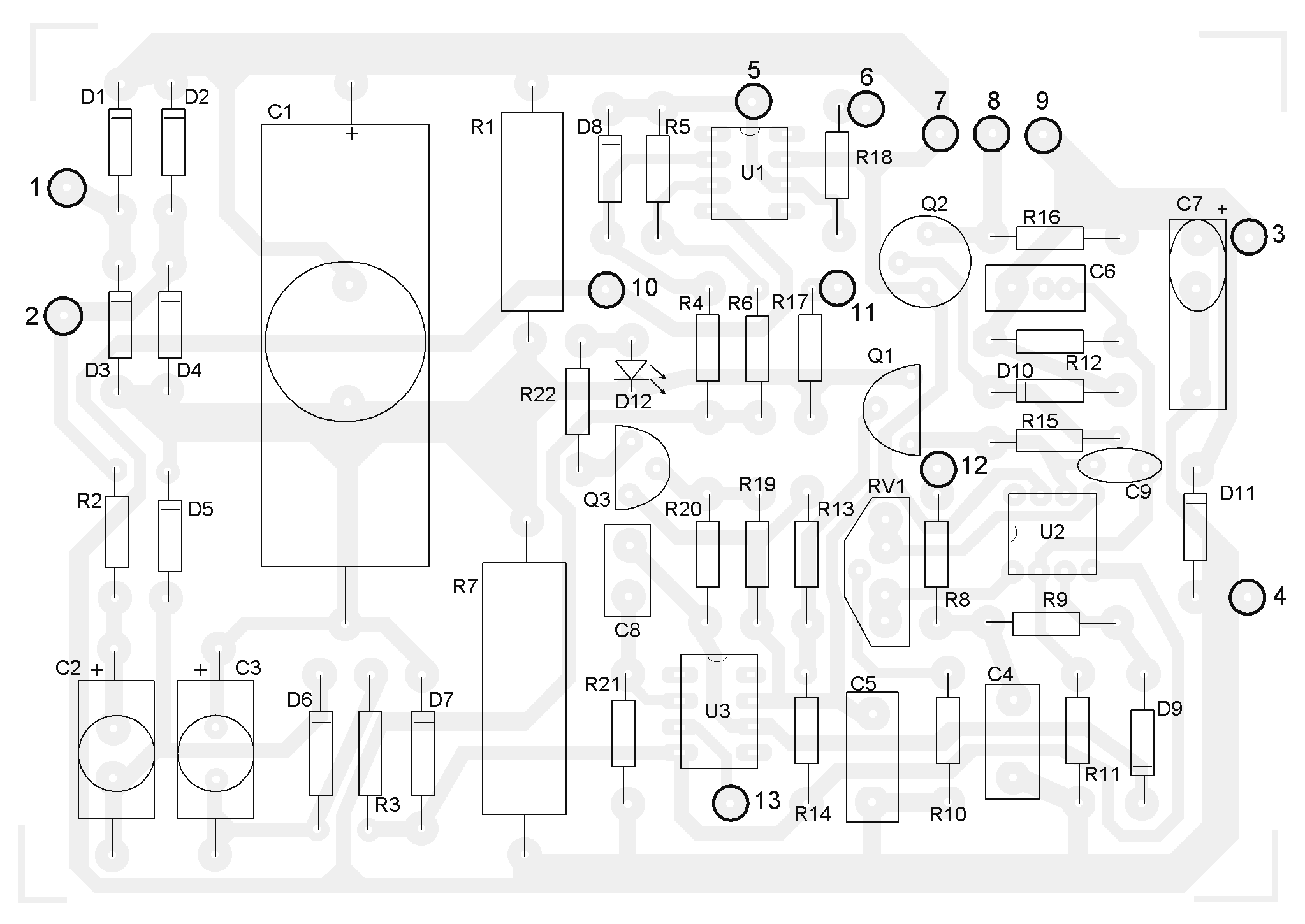



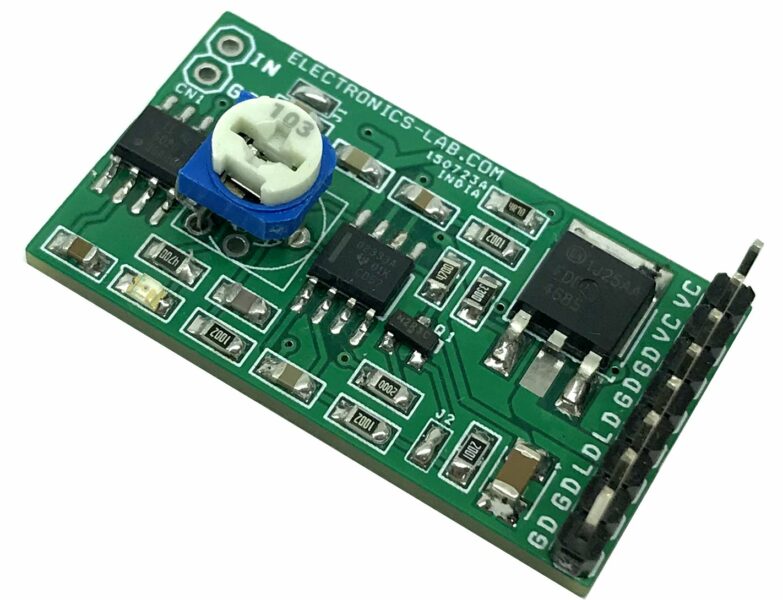
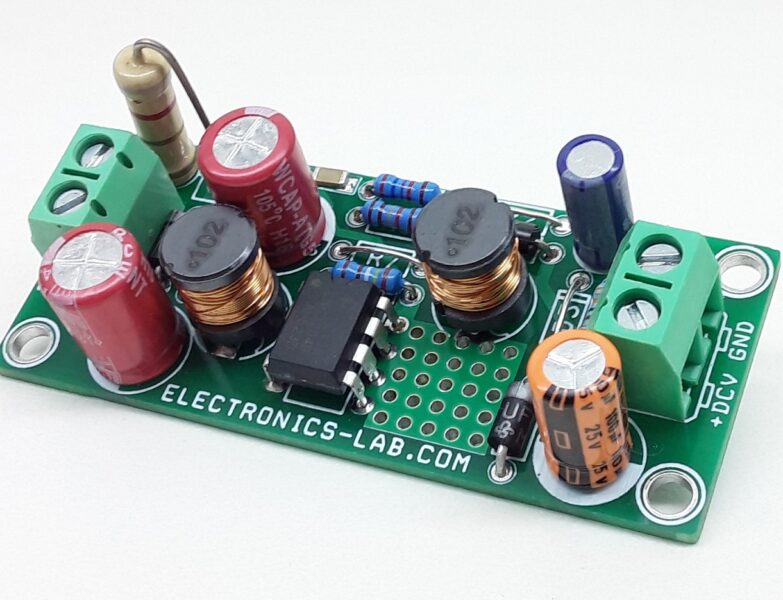
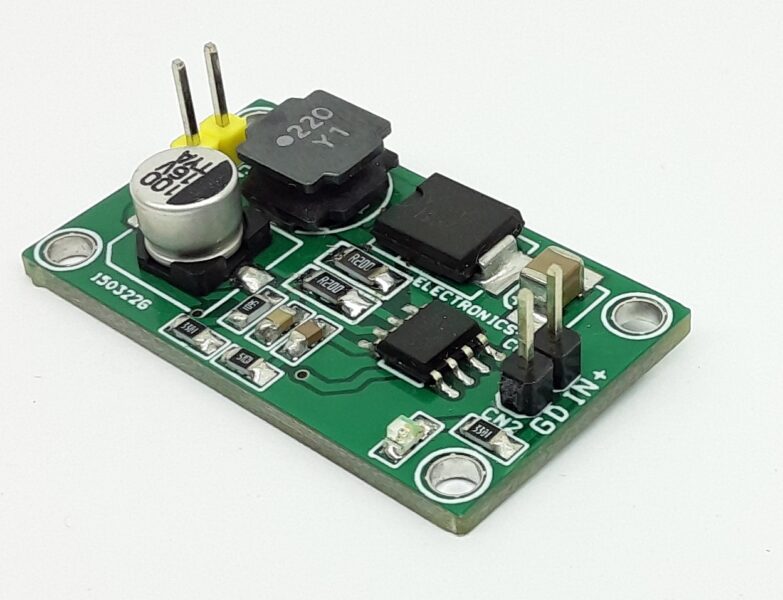
voltages is stay at 34V when power is on. P1, P2 and RV1 are disabled. any suggestions for this is apprecieted.
Please double check your connections and parts orientation according to PCB layout. Also check the Q2 and Q4 for fault.
please i need help u3 is overheating
pls can someone help me with some changes I will have to make if I was limited to using discrete components throughout
There is a discussion on the forum about this power supply, where you can get some help. https://electronics-lab.com/community/index.php?/forum/107-projects-qa/
in this ckt aux supply of tl081 …near about 39 v & in spec.. +- 18 is it right?
In spec maximum voltage is 36Vdc
I don’t know whether this has been said before but the circuit was published in Practical Electronics Oct 1978. I built two and they have been working fine for 30 years and more
your circuit is same as published here or any modification is there.what type of ic and transistor you have used.
My PSU journey. Starting with the banggood kit.
First I put to one side the rectifier diodes, op amps, pass transistor and smoothing cap. My transformer was a 12.0.12 toroid at 6A. I paralleled both outputs to give 12 amp headroom. The rectifier diodes were swapped from 3 to 10amp devices and all op amps replaced with devices from quality suppliers (RS etc.). The smoothing cap is a pair of Rubycon ZL 2200uF in parallel. The pass transistor was swapped for a pair of tip3055s and 0.01ohm 3W balance resistors on a 1.2c /W heat sink. A 5A NTC was added to control switch on surge with the low ESR caps. I have yet to mod the current limit to max out at 5A but everything works fine so far.
My thinking was that 99% of all experimentation is done at 12v or less and usually around 1A, so why build to 30v? I have loads of headroom, a cool supply and something that should be reliable.
how to add digital voltmeter ammeter module in this project
You can add a digital voltmeter like this one: https://www.electronics-lab.com/project/led-display-digital-voltmeter/ or https://www.electronics-lab.com/project/digital-panel-meter-dpm-dvm/ This meter is connected in parallel to the output of power supply.
Here on aliexpress two examples:
Voltmeter
https://fr.aliexpress.com/wholesale?catId=0&initiative_id=&SearchText=5+Chiffres+0.36+%22DC+0-33.000+V+Num%C3%A9rique+Voltm%C3%A8tre
Ammeter
https://fr.aliexpress.com/wholesale?catId=0&initiative_id=SB_20170517140332&SearchText=0.36+%225+Chiffres+0-3.0000A+DC+Amp%C3%A8rem%C3%A8tre+Num%C3%A9riqu
OK, I got this running.
Unregulated supply mods:
0-30V 100W transformer (should have got a 120W – the 100W is a little out of spec at full output 30V@3A, as the drive circuitry soaks up about 20W or so).
8A bridge rec
A big cap is needed to reduce ripple at full output. I used 2 x 6800uF caps. A 10000uF would have done, but I got the 2 smaller caps cheaper.
This gives (unloaded) 46V DC, at rated (3A) output that should be 41V DC.
Now the mods to main circuit:
D7 is replaced by 2 x 1N4148 to get a -1.3V negative rail. No need for any more volts.
U1 & U3 are run from a zener diode connected to the unregulated +ve supply, a 15V zener drops the voltage plenty enough.
Q3 & R19 use the same zener as U3.
U1 pin 4 moved to pin 4 (junction of R7/C7).
Q4 is doubled up, adding 0.1Ohm 3W emitter resistors.
U2 is a MC33171, it is within spec with the unregulated DC supply and was quite cheap for me to buy. R10 is a wire link for this opamp.
U1 & U3 are TL071, no particular reason, any old cheap utility opamp will work, 741s, anything.
The Q4s are on a big heatsink sat outside the project box. 1.5C/W I would say is minimum.
So far, so good.
Hi Anon,
Can you share the updated schematic please.
Check this forum topic: https://electronics-lab.com/community/index.php?/topic/40835-0-30v-0-3a-latest-data/
Yes, almost identical to schematic in the first post in that thread.
Except I ran U1 from its own 15V zener, as my U1 is a TL071 and the unregulated +46V DC is a bit much for it.
Also I changed R13 & R14 like the schematic in 1st post, to account for -1.3V rail.
Also, Q2 will need a decent heatsink as it dissipates 2 or 3W at full output into a short, I used a piece of aluminium about 25mm x 75mm
Quick update:
“D7 is replaced by 2 x 1N4148 to get a -1.3V negative rail. No need for any more volts.”
With a TL071 for U3, I used 4 x 1N4148 to get -2.6V.
With only -1.3V the output of U3 did not go low enough to correctly current limit into very low resistance loads (e.g. short).
Hi,
I build this Power Supply yesterday and my current control does not work. I checked for shorts and dry solder joints. What can caues this Problems, pls help.
Did you used a load to test the power supply operation?
Yes I used a 60 Watt Car Lamp, and I found my mistake. For R17 I accidentaly used 33k Ohm and not 33 Ohm. Now it workes great. Just like I hoped, and for sone reason the maximum output current is 4,5 amps, bit thats is not that bad, because I use a 15V 5A Transformer.
Hi,
I modified this design (you can not call it modification really) to work with two switching PSUs (+30/-9 DC input instead of using a transformer) Wondering what limiting the maximum current to 3 amps. Is it the R7 value or Q4 maximum power? Is it possible to use a more powerful transistor for Q4 and if it is necessary a lower value for R7 to achieve higher maximum current?(around 7-10 amps)
Thank you for this great design. Works perfectly
Can u give me your modified circuit diagram
There are many topics on the forum discussing about this power supply. Check here: https://electronics-lab.com/community/index.php?/forum/107-projects-qa/
“Wondering what limiting the maximum current to 3 amps.”
Power considerations… heatsinks.
This design really needs about 0.7deg/W for Q4 on 3A@30V output into a short. With a fan on the heatsink you get away with a smaller one as I did (1.3deg/W). To be properly rated with a passive heatsink… that is a big heatsink.
If you go to between 6A – 10A you also need to cool the bridge rec, make careful choice (maybe even two trans in parallel) of Q2 (2N2219 is not high power, Q2 needs to handle around 10W if output is 10A) and its heatsink will be significant. The main heatsink for your Q4s will need to be suitably large, almost certainly actively cooled, at which point thermal protection becomes a very desirable feature.
Probably some other detail changes needed too.
Yes, 0R47 would also change, but that’s the easiest bit and needs almost no thought 🙂
i’ve fond in the net two separate diagrams of this power supply with different zeners and diode values 5.6v against 5.1v, 1N4004 against 1N4001 !
what should i retain to realise this power supply ? thank you for your help.
sit is that this supply have short short circuit protection ?
Hello Electronics Lab
I think your design looks exciting because it uses single opamp. Is it stable to HF? I would like to go a little in a different way and make it powerful … very powerful .. 0-18V / 50A and with a switch 18-36V / 25A. Transformer 2x16V 1000W
I have a few questions.
1. Which opamp can be used instead of the TL081 due. Supply up to 47V.
2. U3 should I have to work with a smaller voltage.
(R7x3A = 1,41V) I would like to have the down to R7x50A = 0,50V (1A = 10mV) P2 switched to multiturn (x20)
3. Q2 I switch to 1xTIP141T and Q4 are 40xTIP141T, but can the voltage regulation still reach 0 and up to 36V
Can someone please explain me how U1 works? I am having 0 volts at pins 2, 3 and 6. It should start raising voltage at pin 6 until D8 conduct, but it happily stays at 0V. Using 5532 there – I tried few new, all works the same (I mean, it is not broken). What voltages should appear on pins 2, 3 and 6? Pins 4 and 7 are on power supply, 0V and around 35V. No short connections, everything seems fine.
“What voltages should appear on pins 2, 3 and 6? Pins 4 and 7 are on power supply, 0V and around 35V. ”
pin 2, 5.6V
pin 3, 5.6V
pin 6, 11.2V
check again for correct connections, and/or try it with R18 and P1 removed.
BTW 5532 is a dual chip, pinout is different, pin 1 is OP, pin 2 is inv IP, pin 3 is non-inv IP. You know that I assume.
Thanks! I’ve put those 5532 on a protoboard and found a defective 5532. Not used before. Probably it comes from Chinese production.
I have a question about this power supply. I am attempting to create a pulsed DC current suitable for electroplating. One of the issues with ripple and that creating pulses tends to make voltage spikes in a constant current rectifier. I’ve tried a simply chopper circuit bench power supply hooked up to the anode with limited but promising results. I’m theorizing its these voltage spikes keeping it from being ideal. Would this type of power supply avoid these spikes due to its constant gain amplifier? Could something like this be modified to deliver pulsed DC current? Thanks in advance!
I built this project and it is working from 19 to 27 volts and the current limitation works, but I can’t find out why it does not go down to 0 volts. Could you give me a hint?
Double check 2N2219 and 2n3055 (polarity and condition). 2n2219 at emiter goes from 0v to 10v, check this 0-10 at 2n3055 base too.
Hello to all
Forgive my broken English, I use a translator.
I read the long article on this project and I have some questions to ask your community.
– Who managed to complete and test this project?
– What is the % regulation (difference between load voltage and full load voltage)?
– Which schematic would you advise me to use?
– Is there a quirky available for burning?
Regarding the voltage display and intensity, I have chosen them for their quality, precision and … the price!
While this can be useful:
https://www.aliexpress.com/wholesale?catId=0&initiative_id=SB_20160915075211&SearchText=DC+0-4.3000-33.000V
https://www.aliexpress.com/wholesale?catId=0&initiative_id=SB_20160915071342&SearchText=DC+0.0000-3.0000A
Thank you in advance !
Terence
Wait hold on, I will quote sir Ivan’s first point, “2N3055 will overheat, so you have to connect two of them in parallel with emitter resistors 0.1ohm/5w.”
Does he mean there would be two of these power transistors (2N3055) connected in parallel on the same 7,8 & 9 connections (on the PCB-component design) and each of these would have an emitter resistor in their own respective parallel branches? Just need a little clarification before I completely fire up the PSU.
You do not have to worry about heating if you use a really good computer’s cooler with fan. Remember, at full power, the power delivered is 90 watts.
Hold on, but where on the 2N3055 power transistor should I put the resistors? Should I put it on the collector, emitte or base..? Thanks for the cooling tip though
Be aware that if your circuit doesn’t work, maybe you didn’t know that electrolitic and polyesther capacitors are not the same… (C4, C5)
Someone asked about printed board – complete DIY kit with excellent 2 sided board on Aliexpress is under $7 with free shipping. I bought 2 and both are already in use. You need to add transformer and cooler (the one from old processors or graphic cards works the job, but just replace 7824 with 7812). Great stuff!
I did exactly the same thing, bought a board at Aliexpress, put a transformer and a 7812 and is working perfectly.
By the way, also build the project shown here. I have both versions running. I’ll post the photos of the assemblies.
Feel free to post your experiences building this PSU on the forum: https://electronics-lab.com/community/index.php?/forum/107-projects-qa/
can anyone please tell me why U3 is getting hot when i turn it on i cgecked but al my parts are in the right position
I had just built today this power supply using the schematic and pcb lay out and everything works fine,maybe you have a bad solder or some parts are wrongly placed, recheck all connections and all soldered points it should looks shiny if properly soldered.
I’ve mounted this project and some modifications …
First: Isolate the power supply to the op amp. By connecting with a 7909 with a 16v zener on the common pin, connected to ground, so it arrives 25V in the VCC of them.
Second change: I placed a 1n4007 before R2, so R2 gets half the voltage … There is no reason to use R2 before rectification. If you rectify before, R2 does not heat up.
Third: You can put a 1K Potentiometer in series with the 10K voltage, so you can make a finer adjustment.
Fourth: I used a capacitor of 4700uf 63V in the filtering in C1
But the project is very good, the filtering is very good, without any noise … I really enjoyed riding.
hey dear, can you please tell me how to add fine volume for voltage and current ?
please make a simple drawing with ms paint if its possible. i can’t do that with volume series. because in this pcb all 3 pins of volume are used and i just know how to series Potentiometer when they used 2 pins (middle and one of corners!)
sorry for my bad english.
There is a long thread on the forum discussing improvements of this power supply. Check it here: https://electronics-lab.com/community/index.php?/topic/26825-0-30-vdc-stabilized-power-supply/
I’ve tried simulating it on Multisim but couldnt get it to work. Checked the connections and all, not sure where the problem is. Can anyone give me their email and i’ll send the multisim design for u to check.
Please post this on the forum. Thanks
I’ve tried simulating this power supply on Multisim but it’s not working. Output voltage equals 0 and it can’t regulated. Could you pleas help me ?
https://drive.google.com/file/d/0B9i6g_EFCtdJb3B6aFlfRzFkVzA/view?usp=sharing
Hi
I build this as a kit from bangood. It Failed because;
Power supply was from a 25V transformer which delivers 42Vdc when rectified and not loaded. Add Minus 5.1V for the negative and The TL081 are supplied from 47V. They blow right away, this is why the negative supply then turns up to .8V as some have found. That in turns kills Q1. Very difficult to repair then.
Would need a lower Xformer in order not to exceed 36Vdc which is the limit for TL081. That means 31VDC max out of the rectifier. Then it could be virtually possible to deliver 30V out, but Hmmm…
Cheap thing but a frustration.
42 V DC means around 30.5 V AC (29.8+0,7). That is one weird transformer that gives -6.5 V with just a little current as a load. I wonder what is voltage drop on 3A load then?
Everything works OK except 1 thing. In constant current mode output has ripple for above 200 mv peak to peak, which is not normal as I think. if anyone has this problem please suggest
hi,
I can not run with the simulator Multisim this project, but not even the original project.
Someone can explain why?
Waiting your kind reply.
Thank and a greeting.
Alex
It’s difficult to debug your circuit here.I would suggest to post more details on the forum. Thanks
How do I attach the Multisim source here?
Please send it on the email found here: https://www.electronics-lab.com/contact-us/ and i will take care of the rest. Thanks
Done, thank.
lm741 op-amp will work as replacement??
Tried, but in Multisim does not work.
Thank and a greeting.
LM741 should work as replacement.
Hyy it works for me some complications but i solved it myself.and i can also help u either with detailed picture of power supply and also make it for u.. so if anyone intrested then contact me and derailed video is also available on youtube search for aviprink avinash.aviraj123@gmail.com
Thanks for your comment. Feel free to post your experiences building this psu on the community, this way you will help others that want to build it.
can you make it to deliver constant current and also constant voltage by this designed power supply